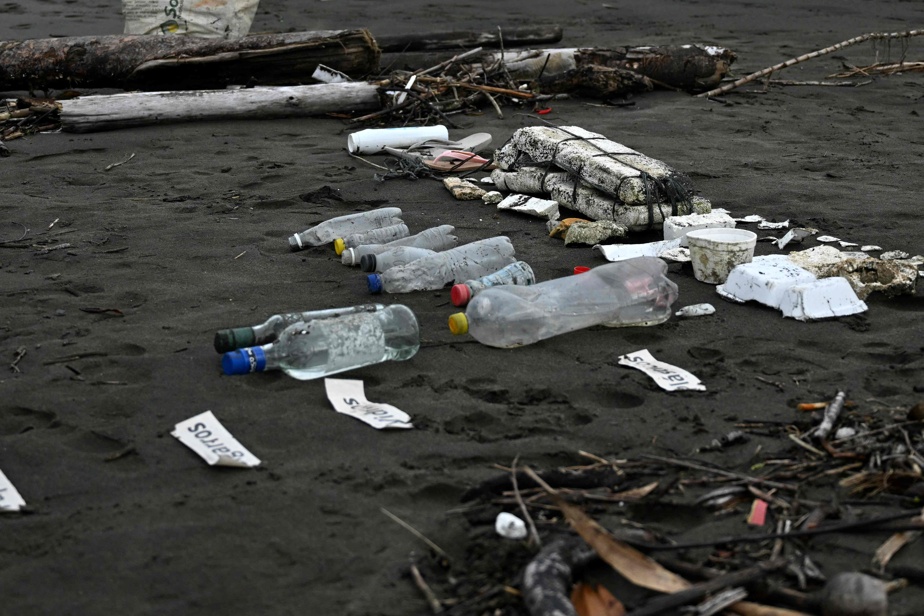(Buenaventura) In the Colombian Pacific, plastic collected on beaches and recycled has become currency: a small economy that helps children while mitigating the pollution that affects a paradise and poor destination in the country.
In Bahia Malaga, an inlet belonging to the municipality of Buenaventura, children come to the window of a colorful wooden building.
In exchange for the plastic caps collected in this tourist territory, but strewn with rubbish, they receive fictitious coins, also made of plastic, valid to “buy” clothes, school supplies, toys, books or pop- corn to eat while watching movies.
This region with a predominantly black Afro-Colombian population is fighting against pollution to preserve its exuberant nature, one of the themes that will be debated from October 21 to 1er November in the neighboring city of Cali (southwest) on the occasion of the COP16 on biodiversity.
One fictitious coin is equivalent to 250 grams of plastic collected. The products that can be obtained in exchange were donated to the “Plastico Precioso Uramba” foundation, an NGO that implements this program on the beaches of the national natural park of the same name.
In this way, this eternal “waste problem is transformed into an incentive for local economies,” Sergio Pardo, its 36-year-old director, explains to AFP.
Sea trash
Inexorably, the sea spits out countless plastic waste onto the park’s beaches. Since 2019, the foundation has collected some 16 tonnes of waste in Malaga Bay, estimates Mr. Pardo, a former diver and long-distance captain of a catamaran owned by a Colombian millionaire.

PHOTO JOAQUIN SARMIENTO, AGENCE FRANCE-PRESSE
Sergio Pardo
His NGO essentially lives off donations and voluntary contributions from the few tourists who come to do a good deed by collecting waste.
The local children are also his partners. “As there are a lot of lids, I collect them […] Then he takes them to the store,” says one of these little hands, Juan José Lopez, 13 years old.
Every year, according to the UN, around eight million tonnes of plastic end up in the oceans.
In Bahia Malaga, only accessible by sea and a privileged observation post for watching whales, these plastic bottles are omnipresent, washed up on the black sand or floating on the waves.
Mr. Pardo and a group of friends walk among tourists on the beach, where they mark off a 3×3 meter plot. In this small area alone, they find dozens of plastics, pieces of glass and metals.
Some of these materials have a market value, others decompose, but plastic remains floating in the oceans for years. Or it sinks. “What doesn’t float must unfortunately be found on the seabed or in the mangroves, trapped in the roots.”
He sometimes found bottles with labels written in Mandarin, probably discarded from the many Chinese ships traveling to Buenaventura, Colombia’s most important port on the Pacific.
Other bottles displayed prices in dollars rather than Colombian pesos. Mr. Pardo therefore suspects that they came from neighboring Ecuador.
From the beach to school
Stiven Obando, 19, accompanies his friend in the cleaning work. “No matter how much we clean now, it will be dirty again later. The ocean is constantly moving and throwing out more and more waste,” explains the young tourist.
The United Nations estimates that 85% of the waste that pollutes the oceans is plastic.
In Bahia Malaga, sea air and bad weather corrode wooden school desks. Mr. Pardo therefore decided to make his small contribution to improve the daily lives of the students.

PHOTO JOAQUIN SARMIENTO, AGENCE FRANCE-PRESSE
A classroom desk made from recycled plastic.
In his workshop, he sorts plastic caps by color and reduces them to flakes in a machine. He then places this powder in a heat press at 190°C that he built himself from a sketch found on the internet.
The end result is a heavy plastic board, made from the flakes of around 2,000 corks. With just one of these boards, he builds a colorful desk which he gives to the classes who have contributed the most to his litter collection program.
Dozens of children are already studying on comfortable chairs and desks made in this way. “We are seated well, well wedged in our chairs […] we can write well now,” rejoices little Juan José.
His teacher, Soraya Hinestroza, bears witness to the change, thanks to the hundred or so desks distributed. The children “were very diligent in this process,” she says. “In fact, the impact is already visible” on this community of nearly 4,000 souls.
